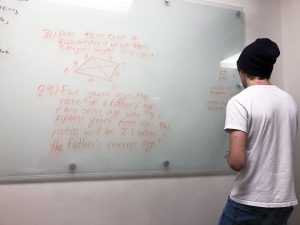
by Mia Sword
If asked to describe mathematics in one word, many people would respond “hard” or “ew!” It’s easy to perceive a world full of numbers as a bunch of nonsense jumbled together with obscure rules or a language filled with random symbols and Greek letters. Yet, the VAMPY students in Mathematics, a course involving rigorous studying, challenge problems, origami, and lectures, have started to unravel the secrets of this subject.
You may not think of yourself as encountering math in your daily routine, but if you were to look closely — at the very screen on which you’re reading this post, at the medicine you just took to relieve your headache, or even at the car you used to transport your child to this camp — you would see that mathematics is hidden beneath the surface of our lives. Scientists, physicians, engineers, and many other experts used mathematics to make the discoveries we now take for granted.

So, how can a camp that lasts only three weeks unlock the vast potential of math for its students?
Imagine this: a student sits in her seat as she looks intensely at her textbook. She gets stuck attempting to take the integral of a function. She raises her hand, and a TA or teacher helps dispel her confusions by demonstrating new tricks and different methods to solve the problem. Now she has a new look in her eyes. As soon as she understands the whys and hows, she starts asking more questions, and the other students join in:
“How do you find the area between two intersecting congruent circles?”

“For any Pythagorean triple, if we want one of the numbers to be a set value, say eight, how can we find what the other two side lengths could be?”
“What’s the volume of this three-dimensional object we just formed?”
Perhaps mathematics isn’t, after all, some constricting, suffocating subject we remember as the time we were forced to graph 50 equations by hand. Instead, it’s a tool we can learn to utilize and perfect so that we can answer more of life’s mysteries. At VAMPY, students are able to ask questions that do not “follow the textbook” so that they can start thinking like true mathematicians and make discoveries that allow them to be challenged and engaged at the same time.

